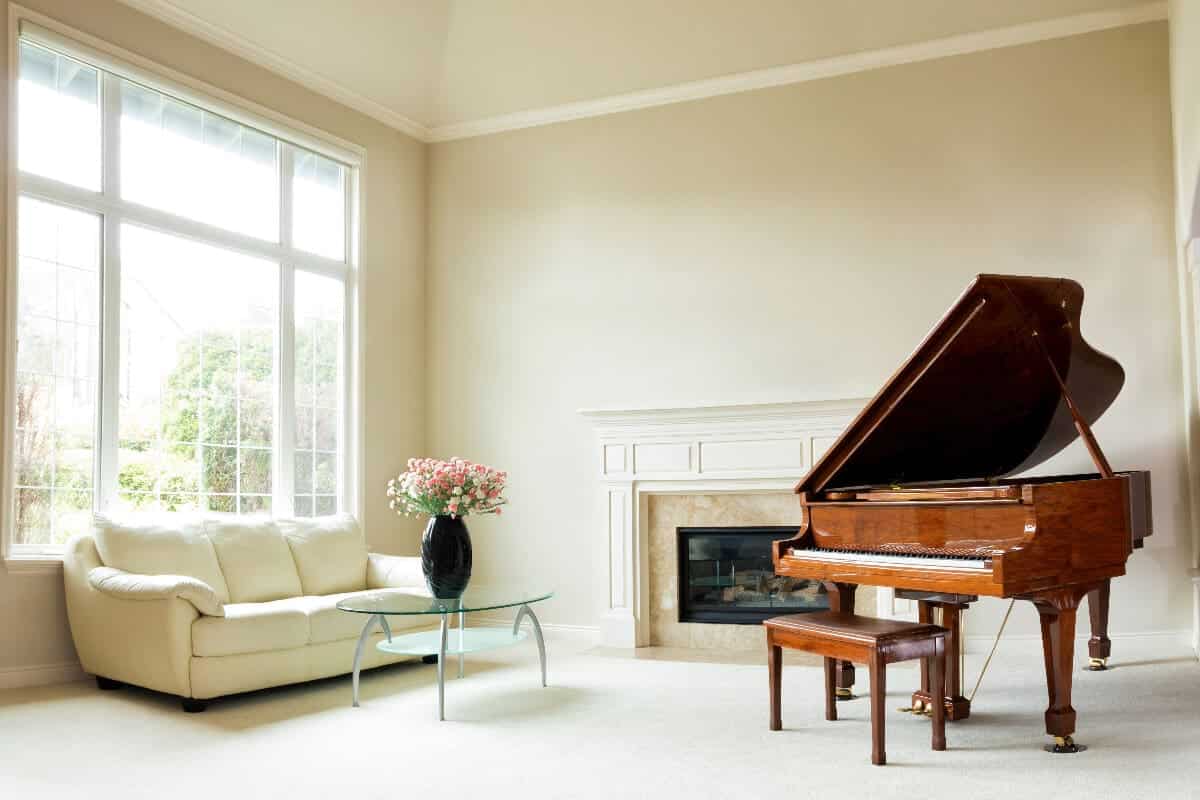Imagine a space that resonates with the musical threads of creativity—a sanctuary where each note and rhythm finds a home. That’s the essence of a well-conceived music room, a place for storing instruments, and a breeding ground for inspiration and artistic freedom.
Delving into the world of music room decorations opens up a symphony of possibilities, where every element harmonizes to create a personalized haven. Whether you’re a seasoned musician or an avid music enthusiast, understanding the importance of a music room’s ambiance is the first step in crafting an environment that amplifies passion and encourages sonic exploration.
Table of Contents
- Understanding the Importance of a Music Room
- Themed Decoration Ideas
- Functional Decor and Acoustic Considerations
- Incorporating Lighting for Ambiance
- Displaying Instruments and Memorabilia
- Related Content
Understanding the Importance of a Music Room
The Music Room: A Harmonious Haven for Creativity
In the heart of every artist’s abode or educational institution is a cherished space that resonates with harmonies and melodies—a music room. This sanctuary, often filled with various instruments and soundproofed walls, goes beyond being a mere practice space. It is, in its essence, a cradle for creativity where the soul communicates in the universal language of music.
To understand why the music room is revered as a sanctuary for creativity, one must first acknowledge that creativity flourishes within spaces that bring comfort and inspiration. These are spaces where restrictions dissipate, and expression knows no bounds.
When one steps over the threshold of a music room, it is like entering an alternate reality. The hustle of the outside world fades away, replaced by an atmosphere thick with potential. Every note played, and every rhythm crafted becomes an experiment in exploration, an unfurling of the soul.
The acoustic properties of a music room are meticulously designed to capture and enhance sound quality. With acoustics fine-tuned to perfection, every nuanced echo is a brushstroke on an aural canvas. In this echo chamber, artists discover the raw sound, untarnished by ambient noise—a purity that invites an undisturbed focus on the craft.
Instrumentation is the paint palette of musicians, and the music room houses these instruments with tender care. Grand pianos command attention at the center, guitars hang on walls waiting to be plucked into melody, and percussions rest in corners, eager to contribute their rhythm.
Surrounded by these musical tools, the artist has unlimited avenues to explore, each instrument offering a different color, texture, or shade to their creative tapestry.
The solitude of the music room is also essential for creativity to bloom. It allows musicians and composers to meditate, where introspection leads to transcendental creations. The isolation is not one of loneliness but is an intimate dance between artist and music—a relationship cherished and uninterrupted.
Collegiate laptops and seasoned notepads typed with lyrics and chord progressions lie scattered, ready to document flashes of brilliance. The music room also often serves as a repository of inspiration, lined with shelves housing music literature, albums from influential artists, and perhaps even personal memoirs encompassing years of the artistic journey.
Collaboration is another aspect that turns the music room into a creative powerhouse. The ensemble of diverse talents blending in this room unleashes a synergy impossible to replicate in any other setting. It’s where artists learn from one another, challenging and inspiring creativity through camaraderie and shared passion.
A music room, therefore, is not simply a room in a building. It’s a breathing entity that exudes life and evokes inspiration. The silence within its walls holds a thousand melodies yet to be birthed.
Whether through the reverberating pulse of a bass guitar or the soft caress of a violin’s serenade, a music room is a bastion for creative minds to journey through the depths of their artistry and emerge with something truly resonant to share with the world.
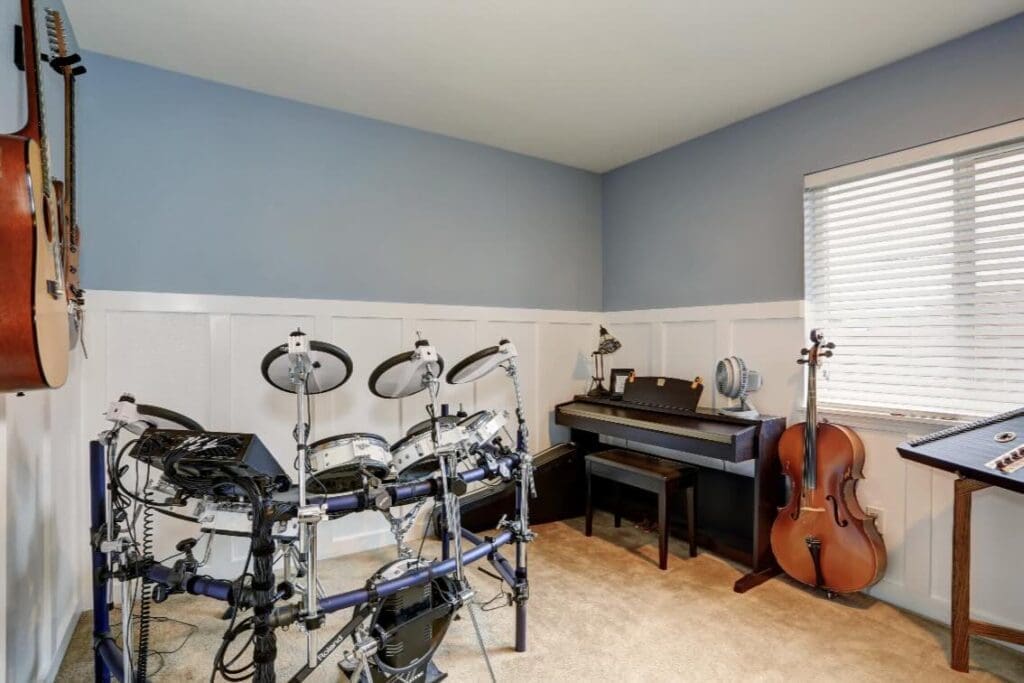
Themed Decoration Ideas
Unlocking the Melody: Thematic Decor Concepts for Enriching Your Music Room
When crafting a space dedicated to music’s rhythmic nuances, the decor should resonate with the same creativity and passion as the melodies that will fill the room. Decorating a music room means harmonizing functionality with inspiration. Every element of the room’s design serves a dual purpose—embodying the aesthetic of a theme and enhancing the creative joules sparking within.
Vintage Vinyl Vibes
For those who appreciate the classics and yearn for the nostalgia of yesteryears, a Vintage Vinyl theme can be particularly evocative. Incorporating antique furniture, such as a weathered wooden piano bench or a mid-century modern record cabinet, sets a historical stage.
Adorning walls with framed album covers from legendary artists or utilizing old concert posters can ignite a sense of lineage in music’s vast evolution. Even the glow from a retro neon sign can add an ambient throwback to bygone jam sessions.
Modern Minimalist Maestro
Simplicity is the keynote of all true elegance. A Modern Minimalist theme could be the perfect score for those who seek to declutter their minds and surroundings. Clean lines and a monochrome palette with stark black or white accents can produce a space that feels both current and timeless. Minimizing distractions allows the focus to remain on the purity of the sound, letting the music be the room’s true conductor.
Jazz Joint Jam
The allure of the smoky, soulful speakeasy where jazz legends spun their magic can be recaptured in a Jazz Joint-themed music room. Deep, rich shades of blue, burgundy, and plush seating offer a lush backdrop. Additions like a brass instrument lamp or a saxophone statuette pay homage to the heartbeats of jazz. Strategic lighting from vintage sconces can cast shadows that dance to the beat of impromptu rhythms.
Bohemian Beats
Freed from the conventional, a Bohemian-themed music room can be a canvas for eclectic tastes. Layering textures with vibrant tapestries and floor pillows creates an inviting space to lounge and let improvisation reign.
A hammock or a swing chair can provide a whimsical touch, while a collage of artistic photographs embodies the freedom and spirit of bohemia. It’s a motif that encourages whimsy and blending genres, welcoming a diverse symphony of sounds.
Nature’s Concerto
Bringing the outside in can be essential for those who find their muse in the whisper of the wind and the rustling leaves. A Nature’s Concerto theme employs elements like bamboo flooring or a water feature to instill a sense of peace and organic harmony.
Using plant life not just for decoration but also as natural sound diffusers blur the line between the outdoors and in, crafting a serene environment where creativity can blossom with the tranquility of Mother Nature.
Industrial Infusion
An Industrial-themed music room can echo the raw, unrefined edges of urban soundscapes. Exposed brick walls, metal accents, and concrete flooring reflect a no-nonsense approach to the craft.
Hanging pendant lights with Edison bulbs could illuminate the space in a warm glow that fuels late-night composing sessions. This theme asserts a sturdy foundation for powerful compositions, much like the genre-bending tracks that reshape the music industry.
In conclusion, a music room’s thematic decor is not a backdrop—it’s a symphony of visual elements orchestrated to kindle the muse and cradle the crescendos and diminuendos of the creative process. Through the thoughtful integration of decor, these concepts can ensure that the music room sings beautifully and amplifies the artistic spirit within.
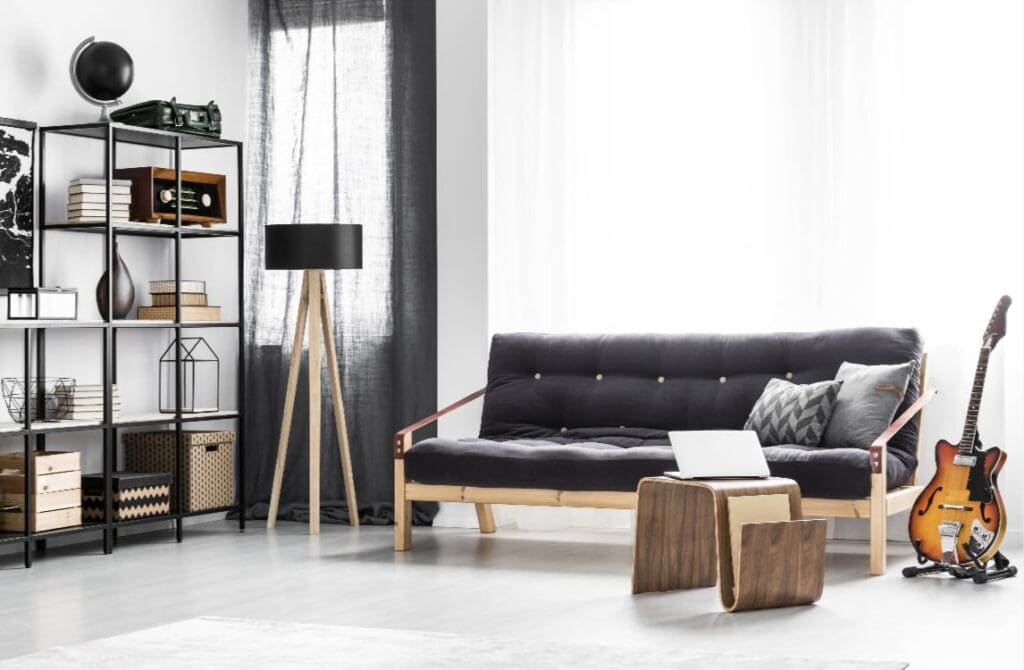
Functional Decor and Acoustic Considerations
A perfectly tuned symphony of sight and sound lies amid the serenade of strings and a whisper of wind instruments. As we delve deeper into the music room’s essence, consider the artistry of integrating decor that not only complements the melody of the space but enhances its acoustic performance to symphonic heights.
Here, amongst the harmonious blend of aesthetics and soundproofing, that decor transcends mere appearance to become a resonant player in the orchestration of sonic excellence.
To strike a chord between functionality and optimal acoustics, it is vital to understand the materials and elements that contribute to superior sound quality. Acoustic panels can be fashioned from various materials, some of which add a touch of texture and color to a room while mitigating unwanted echoes and reverberation.
Imagine fabric-wrapped panels gracing the walls, serving as visual art and covert sound manipulators, allowing clarity and warmth to envelop the listener.
Seating, often necessary in a space designed for musical creation, must couple comfort with sonic sensibility. Furnishings upholstered with acoustic-friendly fabrics and placed strategically can act as sound absorbers, reducing noise levels and contributing positively to the room’s acoustics. Picture plush armchairs that invite reflection and creativity while offering a gentle embrace to the ambient tones of the room.
Lighting fixtures, too, can play a pivotal role beyond mere embellishment. The design and placement of lamps can influence the direction and flow of sound within the room. Opt for fixtures with soft materials or custom acoustic lighting solutions that visually excite while contributing to a stable acoustic environment.
Flooring choices dramatically influence how sound reverberates in a space. A music room adorned with thick, sound-absorbing rugs feels cozier beneath the feet and is a foundational layer in damping unwanted noise. The weaves and patterns of these rugs can mirror the motifs of musical arrangements, pooling together visual and acoustic harmony.
Moreover, integrating greenery in the form of potted plants can be the natural touch that twines visual appeal with acoustic betterment. Plants are more than mere decorative elements; they can scatter sound waves, creating a more muted and pleasant auditory experience. Imagine leafy greens and florals sitting pretty in acoustically optimized planters, turning the music room into a verdant oasis of calm.
Shelves filled with books and records not only present one’s gallery of muses but can also be a practical method for diffusing sound. These literary and melodic collections can scatter soundwaves when tactically placed, thereby subtly enhancing the room’s auditory landscape.
In the dance between decor and acoustics, let each element be purposeful. Let each item sing its note in the visual arrangement, contributing to the overall acoustic composition.
Through intentional design and thoughtful placement, the fusion of functionality and optimal acoustics becomes not just imaginable but achievable – creating a space where every note played is an artwork in itself, visually stunning and acoustically exceptional.
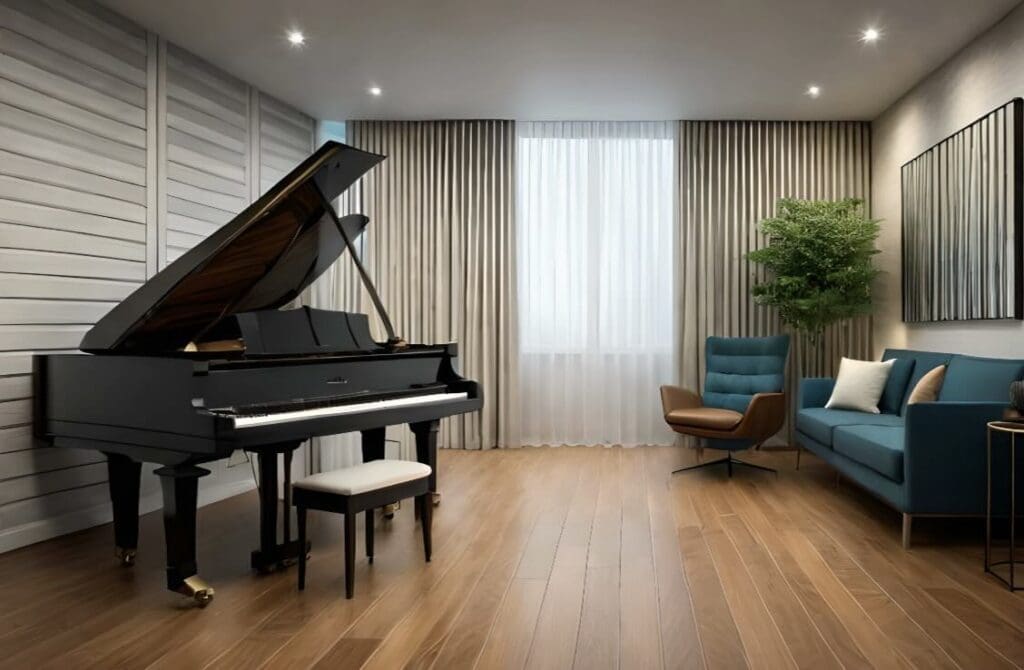
Incorporating Lighting for Ambiance
Lighting the Melody: How Illumination Enhances the Mood in a Music Room
Beyond acoustics and instrument placement, lighting wields a transformative power over the ambiance of a music room. Thoughtful lighting decisions elevate the atmosphere and invigorate or soothe the soul, preparing the mind and space for a symphony of creativity.
The first note in lighting a music room is understanding the relationship between light and mood. Soft, warm lighting sets a tranquil stage, ideal for gentle melodies or reflective composing. In contrast, bright and excellent lighting may stimulate focus and energy, sparking the drive for dynamic rehearsals or innovative brainstorming sessions. An artist’s intention can be manifested through the bulbs they choose.
Layering is a composition’s friend, and lighting is no different—a music room benefits from a mix of ambient, task, and accent lighting. Ambient lighting provides the base—soft overhead fixtures or recessed lights that fill the room without overpowering.
Task lighting is focused and deliberate, spotlighting sheet music or a keyboard, allowing artists to concentrate on detail without straining their eyes. Accent lighting gives life to the room’s features, perhaps illuminated strings of lights dancing along a wall of guitars or subtle backlighting accentuating a piano’s curves.
Controlling the intensity of light in a music room is critical. Dimmer switches grant artists the power of nuance over their space. Imagine the ability to adjust the brightness as one would adjust the volume of an instrument—bringing the light down to a whisper as the music swells or brightening the room to match the crescendo of an inspiring collaborative session.
Special attention to the positioning and direction of light fixtures can guide the flow of sound. Directional spotlights can be angled to avoid unwanted reflections and glare that might distract from the task. Similarly, floor lamps with upward-facing shades can create a diffuse glow that uplifts without causing harsh shadows that could cast over the creative process.
Color plays a vital role in setting the scene. Colored LED lights, with their spectrum of hues, allow for a personalized touch that reflects the character of the music being produced. A cool blue might be the backdrop for a serene composition, while a vibrant red could energize a rock session.
In the modern music room, innovation in lighting technology offers a symphony of possibilities. Intelligent lighting systems sync with mobile devices, empowering artists to adjust settings from anywhere in the room. Programmable scenes can transition the lighting to reflect a shift in the music or mood without missing a beat.
The crescendo of the creative experience in a music room is achieved when every element plays in harmony. Lighting is the final grace note that completes the composition—a delicately balanced presence that, when tuned to perfection, can turn a simple space into a stage that resonates with the heart’s rhythm and the music’s soul.
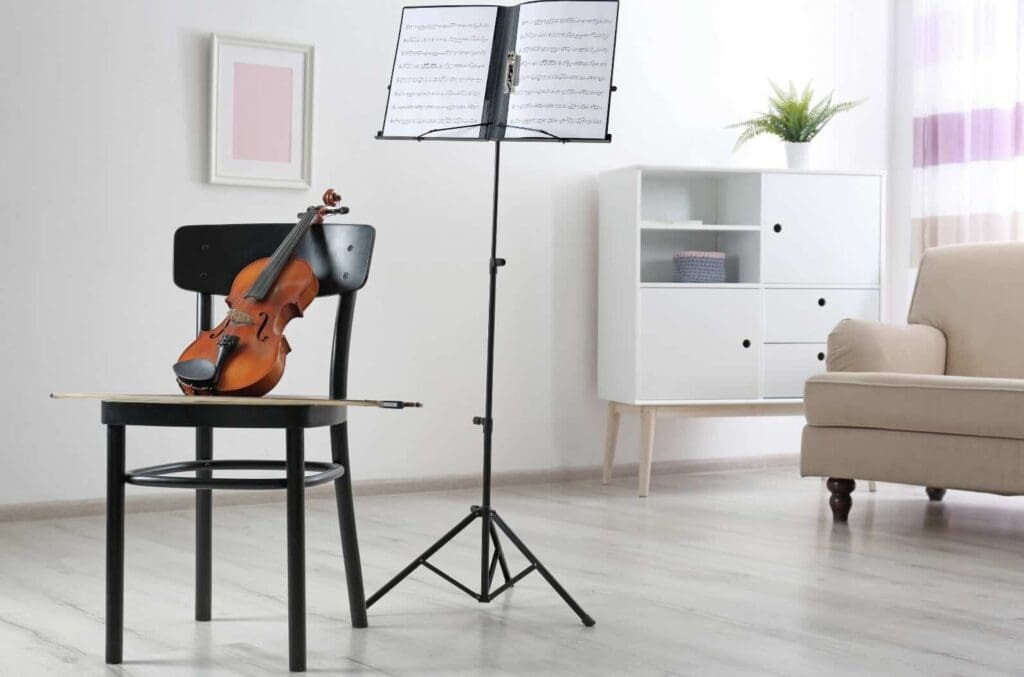
Displaying Instruments and Memorabilia
Creative expressions don’t just flow through melodies and lyrical whispers; they resonate through the very spaces that cradle our beloved instruments and treasured music memorabilia.
The artistry in displaying these pieces goes hand in hand with their sonic counterparts, offering a visual symphony that amplifies the essence of a musician’s sanctuary. Through inventive display techniques, let’s explore the harmony between aesthetic delight and homage to music.
Floating Instruments: A Wall Symphony
Stringed wonders and brass beauties can be elevated from their cases onto the walls as part of a living gallery. Implementing wall mounts provides secure storage and turns guitars, violins, and horns into a visual crescendo. One can arrange these instruments to mimic the flow of notes across a staff, creating a musical narrative on the wall.
Instrument Stands: Sculptural Elegance
Elegantly crafted wooden or metal stands serve as sculptures that celebrate the form and function of each instrument. A saxophone resting on a custom stand reflects a practical need and the melding of craftsmanship and art.
These stands become interactive installations, inviting admirers to ponder the stillness of the instruments and the potential music they hold within.
Memorabilia Montage: Curated Collections
Music memorabilia, from vintage concert posters to signed album covers, traverses history and personal journeys. The narrative woven through these souvenirs unfolds by creating thematic montages on feature walls or within display cabinets. Shadow boxes can encapsulate moments—a guitar pick, a setlist, a backstage pass—and cluster them into a visual encore of a performance past.
Repurposed Casings: History in Harmony
Why tuck away the beautifully worn casings of instruments when they can narrate their journey? Vintage cases can be repurposed as unique shelving or hung open-faced, revealing a collage of concert tickets, photographs, and trinkets from the road, each object a note in a musician’s life story.
Illuminated Legends: Showcasing with Light
Strategic lighting spotlights critical pieces within the space, creating a museum-like reverence. LED strips placed within the body of transparent or semi-transparent instruments can yield a soft glow, turning them into ambient lamps. Autographed memorabilia, underlit or backlit, transcends the realm of keepsakes to become altars of inspiration.
Interactive Memory Lane: Augmented Reality
In the age of digital augmentation, pairing memorabilia with technology opens interactive worlds. QR codes embedded next to memorabilia can link to audio clips, interviews, and performances, transporting the viewer back to the heart-thumping echo of the live experience, all within the comfort of the music room.
Instrumental Canopy: Ceiling Installations
For those with an adventurous touch, the ceiling offers an upside-down stage for stringed instruments to dangle in an orchestrated array from above. This inversion challenges perceptions, allowing the music room to symbolize the boundless nature of musical exploration.
Every chord, every note, has its echo in the physical realm through these innovative displays. Integrating one’s musical passions with thoughtful design transforms a collection into a conversation, an ensemble of the past interlaced with the promise of future symphonies to be composed.
The spectacle of this space becomes a continuous crescendo, inspiring creation, promoting reflection, and memorializing the melodies that have shaped the soul of an artist. Thus, adorned with these displays, the music room flourishes as a gallery, stage, and a timeless archive of the creative spirit.
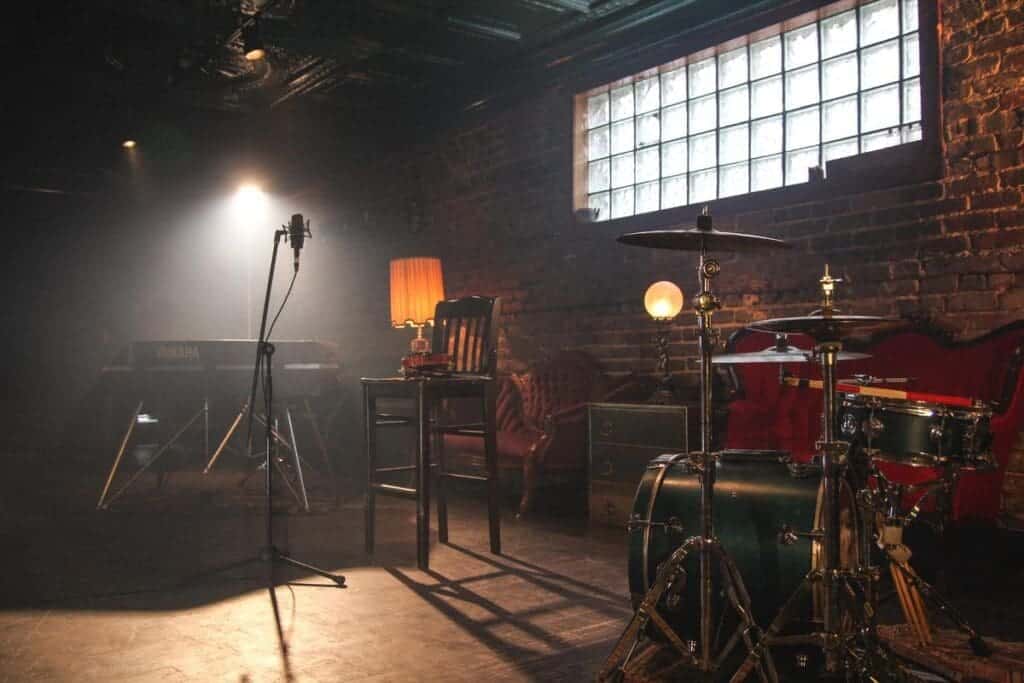
The symphonic journey of transforming a music room into an embodiment of one’s musical spirit is as rewarding as it is intricate. As we’ve meandered through various themes and functional aesthetics, we’ve learned that the music room is not just about appearance but about creating a resonant space that speaks to the musician’s heart.
The perfect music room decor is a visual crescendo, blending passion with purpose and ultimately setting the stage for endless creative flow. Let the room be your canvas, your instruments the paint, and each carefully chosen decoration a brushstroke in your unique masterpiece of melodic expression.
If you are interested in seeing how Mondoro can help you with your handmade home decor products – we would love to talk to you about how we can help you.
Find out more about how Mondoro can help you create, develop, and manufacture excellent home decor and furniture products – don’t hesitate to contact me, Anita. Check out my email by clicking here or become a part of our community and join our newsletter by clicking here.
Mondoro gives out a FREE Lookbook to anyone interested. You can receive a copy of our latest Lookbook by clicking here.
Listen to our Podcast called Global Trade Gal. You can find it on all major podcast platforms. Try out listening to one of our podcasts by clicking here.
Subscribe to our Mondoro Company Limited YouTube Channel with great videos and information by clicking here.
Related Content
Home Decor Vs. Interior Design: A Detailed Comparison
Home decor and interior design are two different aspects of design. These fields differ significantly in their scope, methodology, and objectives. Grasping these subtleties can optimize your domestic or commercial spaces. Read on as we explore some of the unique differences between home decor and interior design and define what each means.
You can learn more by reading our blog, Home Decor Vs. Interior Design: A Detailed Comparison, by clicking here.
Your Chic Entryway: Home Decor For A Memorable Home Entrance
The first impression is often the most lasting, which applies to personal interactions and your home. The entrance to your home serves as the initial touchpoint for guests, an introduction to your abode’s ambiance, style, and character.
To learn more, you can read Your Chic Entryway: Home Decor For A Memorable Home Entrance by clicking here.
Home Improvement Vs. Home Decor: What Sets Them Apart?
In the quest to craft a home that marries functionality with visual allure, they will likely encounter two commonly mentioned concepts: home improvement and home decor. Though easy to confuse for the novice, these separate spheres enrich your home experience in unique ways.
You can discover more by reading Home Improvement Vs. Home Decor: What Sets Them Apart? by clicking here.

